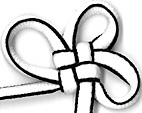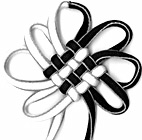AutoPage for Tag chinese Page 2 of 3
This page is automagically created and paginated for each tag available in the posts on this site
I’ve discovered the youTube channel of a 60 year old person (int301) in Taiwan which consists entirely of Chinese knotting instructions. The videos are silent, so the only language issue is the titles of the videos themselves. That’s where I can help a bit. 8) The following translations are not formal with canonical knot names, they’re just off the cuff notes I took for myself when I was looking at the videos
Read more
Notes: As with so many things to do with the history, development and culture of China, Korea and Japan, the situation is not well defined and each has influenced the other. That being said, it is generally agreed by experts in each nation that decorative knotting traditions probably began in China.
Read more
 While the flower knot, when
considered as a polygonal knot, is a family unto itself with many
(many!) variations starting with the number of petals
(ears) and the ways that the structural loops
interlace, the basic square flower knot is also the basic unit of the
mystic knot (see right). Now flower knots can be chained
together via their ears as in the case of the ru-yi knot, but if you
instead extend the structural loops and weave through
them appropriately, you begin to build up a mystic knot.
While the flower knot, when
considered as a polygonal knot, is a family unto itself with many
(many!) variations starting with the number of petals
(ears) and the ways that the structural loops
interlace, the basic square flower knot is also the basic unit of the
mystic knot (see right). Now flower knots can be chained
together via their ears as in the case of the ru-yi knot, but if you
instead extend the structural loops and weave through
them appropriately, you begin to build up a mystic knot.
Read more

 In the next post, I’ll illustrate the relationship, but for now let me just say that the square form of the flower knot (see right) is the basic unit of the mystic knot (see left). The Ashley Book of Knots (also known as Ashley’s or ABoK) has much to say on the topic of mystic knots, but not in those words (Ashley calls this knot family the Chinese butterfly knots), so let’s extract them and put them in one post for easy reference, shall we? I’m making pronouncements based on visual inspection and could easily be wrong, I’ll tie them and post the pictures later, correcting as I go if necessary…
In the next post, I’ll illustrate the relationship, but for now let me just say that the square form of the flower knot (see right) is the basic unit of the mystic knot (see left). The Ashley Book of Knots (also known as Ashley’s or ABoK) has much to say on the topic of mystic knots, but not in those words (Ashley calls this knot family the Chinese butterfly knots), so let’s extract them and put them in one post for easy reference, shall we? I’m making pronouncements based on visual inspection and could easily be wrong, I’ll tie them and post the pictures later, correcting as I go if necessary…
Read more
 The mystic knot is the pan chang knot is the endless knot and is also less commonly known as the coil knot and the temple knot. Pan chang is, of course, the romanization of the Chinese name. The best literal translation of pan chang is probably coil, but the word evokes a much different image for most, I would suspect.
The mystic knot is the pan chang knot is the endless knot and is also less commonly known as the coil knot and the temple knot. Pan chang is, of course, the romanization of the Chinese name. The best literal translation of pan chang is probably coil, but the word evokes a much different image for most, I would suspect.
Read more

